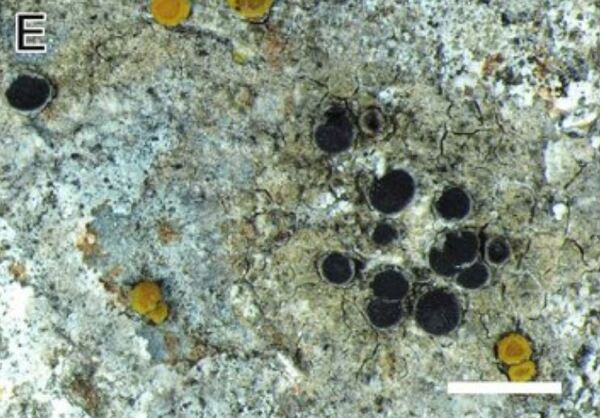Pyrenodesmia microstepposa (Frolov, Nadyeina, Khodos. & Vondrák) Hafellner & Türk
Stapfia, 104, 1: 173, 2016.. Basionym: Caloplaca microstepposa Frolov, Nadyeina, Khodos. & Vondrák - in Frolov & al., Ann. Bot. Fenn, 53: 256, 2016.
Synonyms:
Distribution: N - TAA (Vondrák in litt.).
Description: Thallus crustose, episubstratic, areolate, ochre, grey or grey-white, forming small, orbicular, up to c. 1 cm wide, or much larger and irregular patches. Areoles contiguous, angular to round, flat, epruinose, 0.2-0.6 mm wide. Pseudocortex alveolate, often overlain by an epinecral layer; medulla thin, filled with extracellular crystals. Apothecia 0.3-0.5 mm across, zeorine or rarely biatorine, usually adnate, with a brown to black, epruinose disc, and a thin thalline margin. Exciple c. 10-90 μm wide, formed of a thalline exciple and a non-amyloid true exciple; uppermost part of true exciple with 2.5-4.5 μm, rarely 2-7 μm wide cells; epithecium brown, rarely brown-grey, K+ brown-violet; hymenium colourless, 75-100 μm high, inspersed with numerous extracellular oil droplets, I+ blue; paraphyses 1.5-2.5(-3) μm thick in lower part, gradually widening to 3.5-6 μm in upper part; hypothecium colourless, underlain by an algal layer, with extracellular oil droplets, I+ blue; crystals of calcium salts absent from all apothecial parts. Asci 8-spored, clavate, functionally unitunicate, apically thickened with a broad internal beak, the inner part of apex and external cap I+ blue, Teloschistes-type. Ascospores 2-celled, polarilocular, hyaline, ellipsoid, 12-21 x 4.5-9.5 μm, the equatorial thickening (“septum”) (1-)1.6-3.5 μm. Pycnidia rare, black, immersed in the thallus. Conidia ellipsoid to broadly ellipsoid. Photobiont chlorococcoid. Spot tests: thallus and apothecia K-, C-, KC-, P-, UV-. Chemistry: no lichen substances in thallus, except traces of the Sedifolia-grey pigment, especially in the upper part of pycnidia.Note: a recently-described species known from inland arid and semi-arid regions of Asia and from dry inland localities throughout Europe at altitudes up to 1000 m. In Central and Southern Europe it usually grows on calcareous pebbles and stones, rarely on limestone outcrops or concrete, often in sunny, south-exposed screes and in rocky steppes. The sample from Italy was collected by Arnold at Margola near Predazzo, at c. 1000 m, on limestone (Vondrák in litt.).
Growth form: Crustose
Substrata: rocks
Photobiont: green algae other than Trentepohlia
Reproductive strategy: mainly sexual
Subcontinental: restricted to areas with a dry-subcontinental climate (e.g. dry Alpine valleys, parts of Mediterranean Italy)
Commonnes-rarity: (info)
Alpine belt: absent
Subalpine belt: absent
Oromediterranean belt: absent
Montane belt: absent
Submediterranean belt: very rare
Padanian area: absent
Humid submediterranean belt: absent
Humid mediterranean belt: absent
Dry mediterranean belt: absent

Predictive model
Growth form: Crustose
Substrata: rocks
Photobiont: green algae other than Trentepohlia
Reproductive strategy: mainly sexual
Subcontinental: restricted to areas with a dry-subcontinental climate (e.g. dry Alpine valleys, parts of Mediterranean Italy)
Commonnes-rarity: (info)
Alpine belt: absent
Subalpine belt: absent
Oromediterranean belt: absent
Montane belt: absent
Submediterranean belt: very rare
Padanian area: absent
Humid submediterranean belt: absent
Humid mediterranean belt: absent
Dry mediterranean belt: absent

Predictive model
 Index Fungorum
Index Fungorum
 GBIF
GBIF


